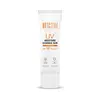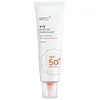What's inside
What's inside
 Key Ingredients
Key Ingredients

 Benefits
Benefits

 Concerns
Concerns

 Ingredients Side-by-side
Ingredients Side-by-side

Niacinamide
SmoothingBeta-Carotene
Skin ConditioningSodium Ascorbyl Phosphate
AntioxidantAdenosine
Skin ConditioningTocopheryl Acetate
AntioxidantPanthenol
Skin ConditioningCentella Asiatica Extract
CleansingSodium Hyaluronate
HumectantIsoamyl P-Methoxycinnamate
UV AbsorberDiethylamino Hydroxybenzoyl Hexyl Benzoate
UV FilterEthylhexyl Methoxycinnamate
UV AbsorberBis-Ethylhexyloxyphenol Methoxyphenyl Triazine
Skin ConditioningWater
Skin ConditioningDipropylene Glycol
HumectantEthylhexyl Methoxycinnamate
UV AbsorberIsoamyl P-Methoxycinnamate
UV AbsorberAlcohol
AntimicrobialStyrene
PerfumingDiethylamino Hydroxybenzoyl Hexyl Benzoate
UV FilterEthylhexyl Salicylate
UV AbsorberNiacinamide
SmoothingC12-15 Alkyl Benzoate
AntimicrobialBis-Ethylhexyloxyphenol Methoxyphenyl Triazine
Skin Conditioning1,2-Hexanediol
Skin ConditioningDimethicone
EmollientHydroxyacetophenone
AntioxidantC10-30 Alkyl Acrylate
Acrylates/C10-30 Alkyl Acrylate Crosspolymer
Emulsion StabilisingSodium Hydroxide
BufferingBetula Platyphylla Japonica Juice
Skin ConditioningSodium Hyaluronate
HumectantMacadamia Ternifolia Seed Oil
EmollientSimmondsia Chinensis Seed Oil
EmollientRosa Rugosa Callus Culture Extract
AntimicrobialLonicera Japonica Flower Extract
Skin ConditioningGlycerin
HumectantSpirulina Platensis Extract
Skin ProtectingLavandula Angustifolia Extract
Skin ConditioningApium Graveolens Extract
Skin ConditioningHyacinthus Orientalis Extract
Skin ConditioningChamomilla Recutita Flower/Leaf Extract
AntimicrobialBarm Extract
Skin ConditioningCentaurea Cyanus Flower Extract
AstringentButylene Glycol
HumectantEthylhexylglycerin
Skin ConditioningCentella Asiatica Extract
CleansingAloe Barbadensis Leaf Extract
EmollientMentha Piperita Leaf Extract
Skin ConditioningEucalyptus Alba Leaf Extract
Skin ConditioningChamomilla Recutita Extract
Skin ConditioningArtemisia Montana Leaf Extract
Skin ConditioningUlmus Davidiana Root Extract
Skin ConditioningPseudoalteromonas Ferment Extract
HumectantYeast Extract
Skin ConditioningPortulaca Oleracea Extract
Skin ConditioningPropolis Extract
Skin ConditioningPanthenol
Skin ConditioningHydrogenated Lecithin
EmulsifyingTocopheryl Succinate
AntioxidantLinoleic Acid
CleansingGlyceryl Oleate
EmollientPyridoxine
Skin ConditioningPolyacrylic Acid
Emulsion StabilisingBiotin
AntiseborrhoeicCyanocobalamin
Skin ConditioningBeta-Carotene
Skin ConditioningSodium Ascorbyl Phosphate
AntioxidantBrassica Oleracea Italica Extract
AstringentLavandula Angustifolia Oil
MaskingRosa Damascena Flower Oil
MaskingOrange Roughy Oil
Skin ConditioningAllantoin
Skin ConditioningXanthan Gum
EmulsifyingPentaerythrityl Tetra-Di-T-Butyl Hydroxyhydrocinnamate
AntioxidantAdenosine
Skin ConditioningDisodium EDTA
Water, Dipropylene Glycol, Ethylhexyl Methoxycinnamate, Isoamyl P-Methoxycinnamate, Alcohol, Styrene, Diethylamino Hydroxybenzoyl Hexyl Benzoate, Ethylhexyl Salicylate, Niacinamide, C12-15 Alkyl Benzoate, Bis-Ethylhexyloxyphenol Methoxyphenyl Triazine, 1,2-Hexanediol, Dimethicone, Hydroxyacetophenone, C10-30 Alkyl Acrylate, Acrylates/C10-30 Alkyl Acrylate Crosspolymer, Sodium Hydroxide, Betula Platyphylla Japonica Juice, Sodium Hyaluronate, Macadamia Ternifolia Seed Oil, Simmondsia Chinensis Seed Oil, Rosa Rugosa Callus Culture Extract, Lonicera Japonica Flower Extract, Glycerin, Spirulina Platensis Extract, Lavandula Angustifolia Extract, Apium Graveolens Extract, Hyacinthus Orientalis Extract, Chamomilla Recutita Flower/Leaf Extract, Barm Extract, Centaurea Cyanus Flower Extract, Butylene Glycol, Ethylhexylglycerin, Centella Asiatica Extract, Aloe Barbadensis Leaf Extract, Mentha Piperita Leaf Extract, Eucalyptus Alba Leaf Extract, Chamomilla Recutita Extract, Artemisia Montana Leaf Extract, Ulmus Davidiana Root Extract, Pseudoalteromonas Ferment Extract, Yeast Extract, Portulaca Oleracea Extract, Propolis Extract, Panthenol, Hydrogenated Lecithin, Tocopheryl Succinate, Linoleic Acid, Glyceryl Oleate, Pyridoxine, Polyacrylic Acid, Biotin, Cyanocobalamin, Beta-Carotene, Sodium Ascorbyl Phosphate, Brassica Oleracea Italica Extract, Lavandula Angustifolia Oil, Rosa Damascena Flower Oil, Orange Roughy Oil, Allantoin, Xanthan Gum, Pentaerythrityl Tetra-Di-T-Butyl Hydroxyhydrocinnamate, Adenosine, Disodium EDTA
 Reviews
Reviews

Alternatives
Ingredients Explained
These ingredients are found in both products.
Ingredients higher up in an ingredient list are typically present in a larger amount.
Adenosine is in every living organism. It is one of four components in nucleic acids that helps store our DNA.
Adenosine has many benefits when used. These benefits include hydrating the skin, smoothing skin, and reducing wrinkles. Once applied, adenosine increases collagen production. It also helps with improving firmness and tissue repair.
Studies have found adenosine may also help with wound healing.
In skincare products, Adenosine is usually derived from yeast.
Learn more about AdenosineBeta-Carotene is a carotenoid. It is an antioxidant that converts to Vitamin A. Antioxidants help fight free-radicals. Free-radicals are molecules that may damage your skin cells, such as pollution.
It gives plants the red, orange, and yellow color. Some foods with Beta-Carotene include sweet potatoes, carrots, apricots, and cantaloupe.
You might know this ingredient as Tinosorb S or Bemotrizinol. It is a UV filter that covers both UVA and UVB rays.
This ingredient has two peak UV absorption peaks ( 310 and 340 nm) and is able to absorb both UV-A and UV-B rays. This ingredient works by preventing UV rays from reaching and damaging your skin.
On top of that - it is highly photostable and helps prevent the photodegration of other sunscreen ingredients such as avobenzone.
Tinosorb S is allowed in the EU, Australia, and Asia. It is close to being approved by the FDA and we'll hopefully get this ingredient in the U.S. by late 2025.
Fun fact: Tinosorb S is the most effective UV absorber at maximum concentration (measured by SPF) permitted in the EU.
This ingredient is oil-soluble, so your oil-cleansers will take this right off at night.
Learn more about Bis-Ethylhexyloxyphenol Methoxyphenyl TriazineCentella Asiatica Extract (Centella) is derived from an herb native to Southeast Asia. It is famous for its anti-inflammatory and soothing properties.
Centella is rich in antioxidants and amino acids, such as Madecassic Acid and Asiaticoside.
Studies show the compounds in centella help with:
The combination of all these properties makes centella effective at soothing, hydrating, and protecting the skin.
Other great components of centella include Vitamin A, vitamin C, several B vitamins, and Asiatic Acid.
Fun fact: Centella has been used as a medicine and in food for many centuries. As a medicine, it is used to treat burns, scratches, and wounds.
Learn more about Centella Asiatica ExtractDiethylamino Hydroxybenzoyl Hexyl Benzoate (DHHB) is a chemical UV-A absorber. It is formulated for high UVA protection (320-400 nm).
DHHB is well-liked for:
DHHB has been approved by the EU, Japan, Taiwan, and South America for use up to 10%. Unfortunately, it has not been approved for use in the US or Canada due to slow regulatory processes.
This ingredient is soluble in oils, fats, and lipids.
Learn more about Diethylamino Hydroxybenzoyl Hexyl BenzoateEthylhexyl Methoxycinnamate is an organic compound that provides UVB protection. It often goes by the more common name of octinoxate. It is created from methoxycinnamic acid and 2-ethylhexanol.
Ethylhexyl Methoxycinnamate absorbs UVB rays with wavelengths between 280-320 nm. UV absorbers protect your skin by using chemical reactions to convert UV rays into heat and energy.
UVB (290-320 nm) rays emit more energy than UVA rays. They are capable of damaging DNA, causing sunburns and are thought to be linked to skin cancer.
The state of Hawaii has banned sunscreens containing octinoxate due to its potential impact on coral reefs. More research is needed to bridge gaps in this research. The European Union allows higher levels of octinoxate in sunscreens than the US and Australia.
Ethylhexyl Methoxycinnamate is oil soluble. It is not stable and may lose efficacy when exposed to sunlight.
Learn more about Ethylhexyl MethoxycinnamateAmiloxate is a chemical sunscreen absorber. It mainly protects against UV-B rays (290-320 nm) but offers a bit of UV-A protection (320-340 nm).
This ingredient is available in the EU (up to 10%) and Asia. However, it has not yet been approved in the US or Canada.
It is created from isoamyl alcohol and methoxycinnamic acid.
Studies show the structural similarities between this ingredient and cinnamic acid give it anti-inflammatory and antioxidant properties. In fact, it is believed amiloxate works by scavenging free-radical molecules from UV.
One animal study found this ingredient was not absorbed or able to penetrate through skin.
Learn more about Isoamyl P-MethoxycinnamateNiacinamide is a multitasking form of vitamin B3 that strengthens the skin barrier, reduces pores and dark spots, regulates oil, and improves signs of aging.
And the best part? It's gentle and well-tolerated by most skin types, including sensitive and reactive skin.
You might have heard of "niacin flush", or the reddening of skin that causes itchiness. Niacinamide has not been found to cause this.
In very rare cases, some individuals may not be able to tolerate niacinamide at all or experience an allergic reaction to it.
If you are experiencing flaking, irritation, and dryness with this ingredient, be sure to double check all your products as this ingredient can be found in all categories of skincare.
When incorporating niacinamide into your routine, look out for concentration amounts. Typically, 5% niacinamide provides benefits such as fading dark spots. However, if you have sensitive skin, it is better to begin with a smaller concentration.
When you apply niacinamide to your skin, your body converts it into nicotinamide adenine dinucleotide (NAD). NAD is an essential coenzyme that is already found in your cells as "fuel" and powers countless biological processes.
In your skin, NAD helps repair cell damage, produce new healthy cells, support collagen production, strengthen the skin barrier, and fight environmental stressors (like UV and pollution).
Our natural NAD levels start to decline with age, leading to slower skin repair, visible aging, and a weaker skin barrier. By providing your skin niacinamide, you're recharging your skin's NAD levels. This leads to stronger, healthier, and younger looking skin.
Another name for vitamin B3 is nicotinamide. This vitamin is water-soluble and our bodies don't store it. We obtain Vitamin B3 from either food or skincare. Meat, fish, wheat, yeast, and leafy greens contain vitamin B3.
The type of niacinamide used in skincare is synthetically created.
Learn more about NiacinamidePanthenol is a common ingredient that helps hydrate and soothe the skin. It is found naturally in our skin and hair.
There are two forms of panthenol: D and L.
D-panthenol is also known as dexpanthenol. Most cosmetics use dexpanthenol or a mixture of D and L-panthenol.
Panthenol is famous due to its ability to go deeper into the skin's layers. Using this ingredient has numerous pros (and no cons):
Like hyaluronic acid, panthenol is a humectant. Humectants are able to bind and hold large amounts of water to keep skin hydrated.
This ingredient works well for wound healing. It works by increasing tissue in the wound and helps close open wounds.
Once oxidized, panthenol converts to pantothenic acid. Panthothenic acid is found in all living cells.
This ingredient is also referred to as pro-vitamin B5.
Learn more about PanthenolSodium Ascorbyl Phosphate is a form of Vitamin C. It is the salt of ascorbic acid.
This ingredient is more gentle than ascorbic acid. It is also more stable when exposed to light and oxygen.
Vitamin C helps reduce redness, improve skin texture, reduce the effects of aging, reduce the visibility of dark spots, and brighten skin.
Your skin uses Vitamin C to produce collagen and collagen production plays a role in having a strong skin barrier and plump skin. As an antioxidant, this ingredient also helps reduce the signs of aging such as fine-lines and wrinkles.
VItamin C helps brighten skin by blocking the process of skin darkening.
In a 2011 study, Sodium Ascorbyl Phosphate was found to have antibacterial properties. This may help treat acne.
Read more about other types of Vitamin C:
Learn more about Sodium Ascorbyl PhosphateSodium Hyaluronate is hyaluronic acid's salt form. It is commonly derived from the sodium salt of hyaluronic acid.
Like hyaluronic acid, it is great at holding water and acts as a humectant. This makes it a great skin hydrating ingredient.
Sodium Hyaluronate is naturally occurring in our bodies and is mostly found in eye fluid and joints.
These are some other common types of Hyaluronic Acid:
Learn more about Sodium Hyaluronate